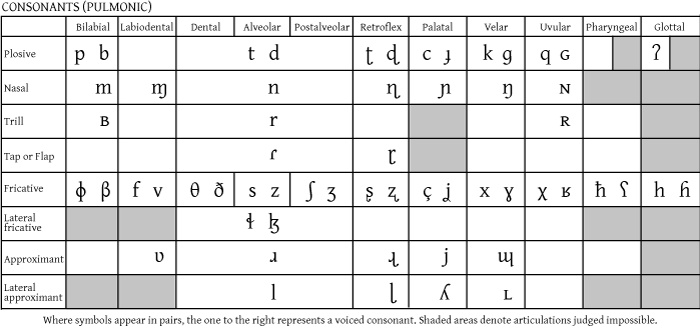In the previous lesson of our International Phonetic Alphabet Tutorial, we dealt with the symbols used to represent vowel sounds. In this lesson, we will examine consonant symbols.
The IPA Consonant Chart
Let’s look at the chart of IPA consonant symbols:
More crazy-looking letters, huh? If you’re overwhelmed, I don’t blame you. As with the vowels, the trick is to learn how this chart works, rather than memorizing every one of these symbols.
Let’s break down the IPA consonant chart so it’s a little more digestible.
Where Consonants Are Produced
You’ll notice that there is a row of phrases at the top of the chart above with brainy words like “bilabial,” “labiodental,” “dental,” etc. You’ll also notice there is a column on the left side of the chart with additional obscure terminology, such as “plosive,” “nasal,” “trill,” etc. Let’s look at what these words mean.
The row of phrases on the top of the chart refers to the part of the vocal apparatus that is used to create the consonant. ( “Vocal apparatus,” by the way, is just another way of saying any part of the body that use to create speech. The vocal apparatus contains your tongue, your throat, your lungs, and many other body parts.)
So this row of fancy phrases on the chart is actually describing something really simple: the part of the body you use to create that sound. “Bilabial,” for example, means you make the sound with your lips.
There’s a simple trick here, which you may have already stumbled upon. On the IPA consonant chart, sounds are written out left to right based on how front or back they are created in the mouth.
So for example, the left-most column of consonants is produced at the very front of the mouth (the lips), whereas the right-most column of consonants is produced at the very back of the throat (the glottis).
With this in mind, you can use the chart above to deduce where in the mouth certain symbols are produced. For example:
/p/, /b/, /m/, /ʙ/, /ɸ/, and /β/ are produced at the front of the mouth (the lips).
/ʔ/, /h/ and /ɦ/ are produced at the very back of the throad (the glottis).
(As usual, don’t worry about what these symbols mean for now.)
But we’ve only talked about the phrases on the top of the consonant chart. What about the words on the left hand side of the chart? What I term the consonants “qualities?” What do I mean by “quality?”
Consonant “Quality”
In reality, what I refer to as “Consonant Qualities” is technically called the manner of articulation. But I think “quality” works as shorthand.
To give you an example of what I mean by the “quality” of consonants let’s look at two basic consonants: the “b” in “bed” and the “m” in “man.” Pronounce both of these sounds, one after the other. Go ahead. I’ll wait.
You’ll notice that both of these sound are pronounced with your lips being pressed together. Because of this, they are both grouped together as “bilabial” consonants, which, as I mentioned, is just a fancy word for “sounds that are created with both lips.”
But “m” and “b” are not the same consonant. That’s because they have different “qualities.” The “m” consonant is a “nasal” consonant, meaning it is pronounced while engaging the nasal cavity. The “b” sound, however, is a “plosive.” That means it is pronounced with the lips “popping” or “exploding” with air. (Other plosives include the “t,” “d” and “k” sounds in English. All of these “plosive” sounds involve a part of the mouth being closed shut, then released with a sharp burst of air.)
Scroll back up and take a look at the IPA Consonant Chart. To review, the phrases at the top of the chart are the parts of the vocal apparatus used to make these consonants. The phrases on the left-hand side of the chart are the particular quality (or manner of articulation) of these sounds.
Of course, I haven’t really explained in depth what these weird words mean. Which brings us to a consonants cheat sheet!
Much as I made a “vowel cheat sheet,” I have created a consonant cheat sheet. You can find it here.
Take a quick break from our tutorial, click on the link above and read over the description of the various consonant symbols. As with the vowels, you don’t need to memorize anything. Just get familiar with the terminology. And refer to this cheat sheet if there’s a symbol you don’t understand.
Still confused? Don’t worry. The truth is, consonant sounds in IPA are a bit more intuitive than the vowels. In English, with a few exceptions, the consonants in IPA are fairly similar to the way we write them with the normal alphabet!
There are, however, a few consonant that we use for the English language that a little bizarre. And these are the topic of Lesson Three.
IPA LESSON ONE * IPA LESSON TWO * IPA LESSON THREE * IPA LESSON FOUR
Copright (c) 2011 by Ben Trawick-Smith. All rights reserved


